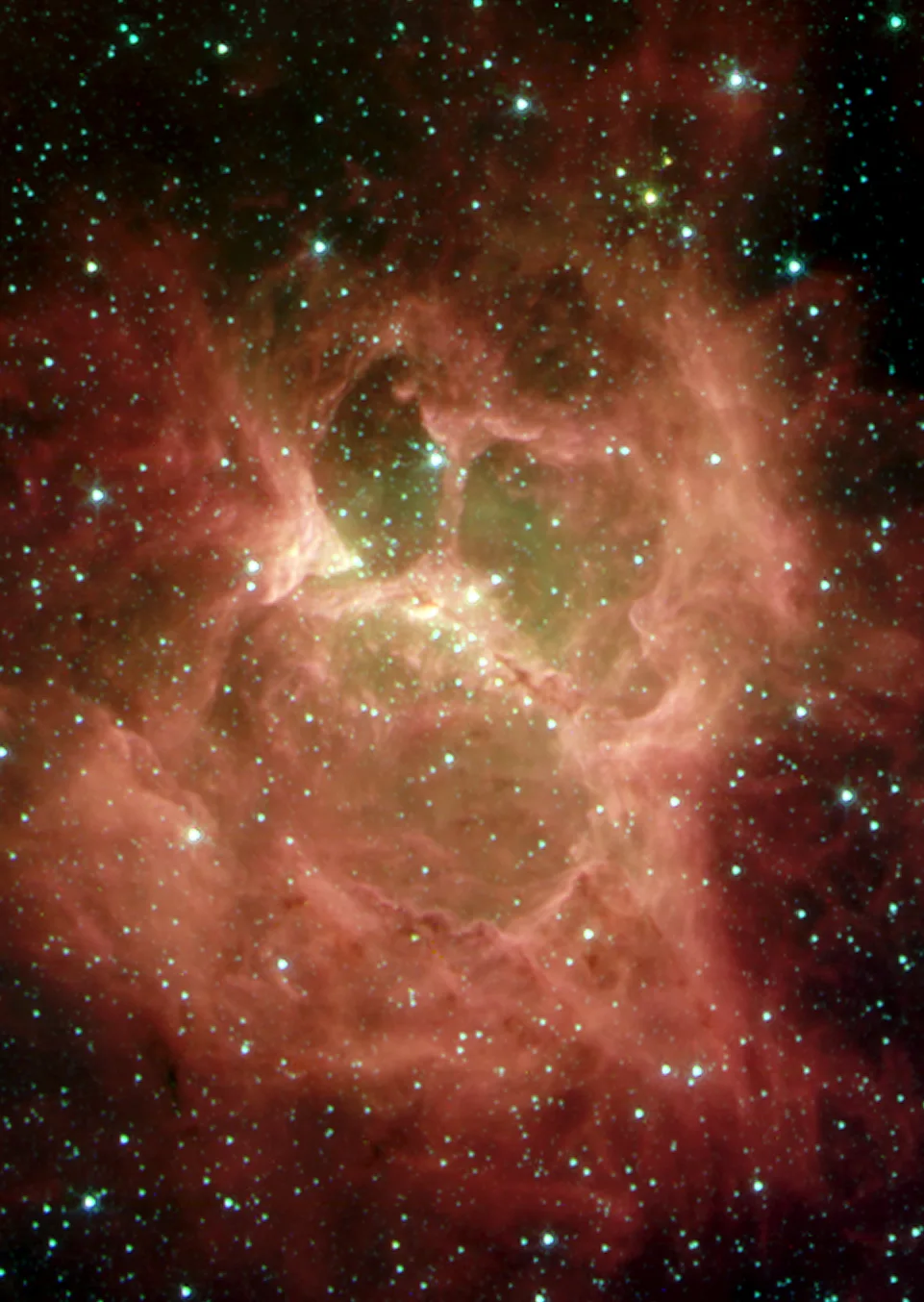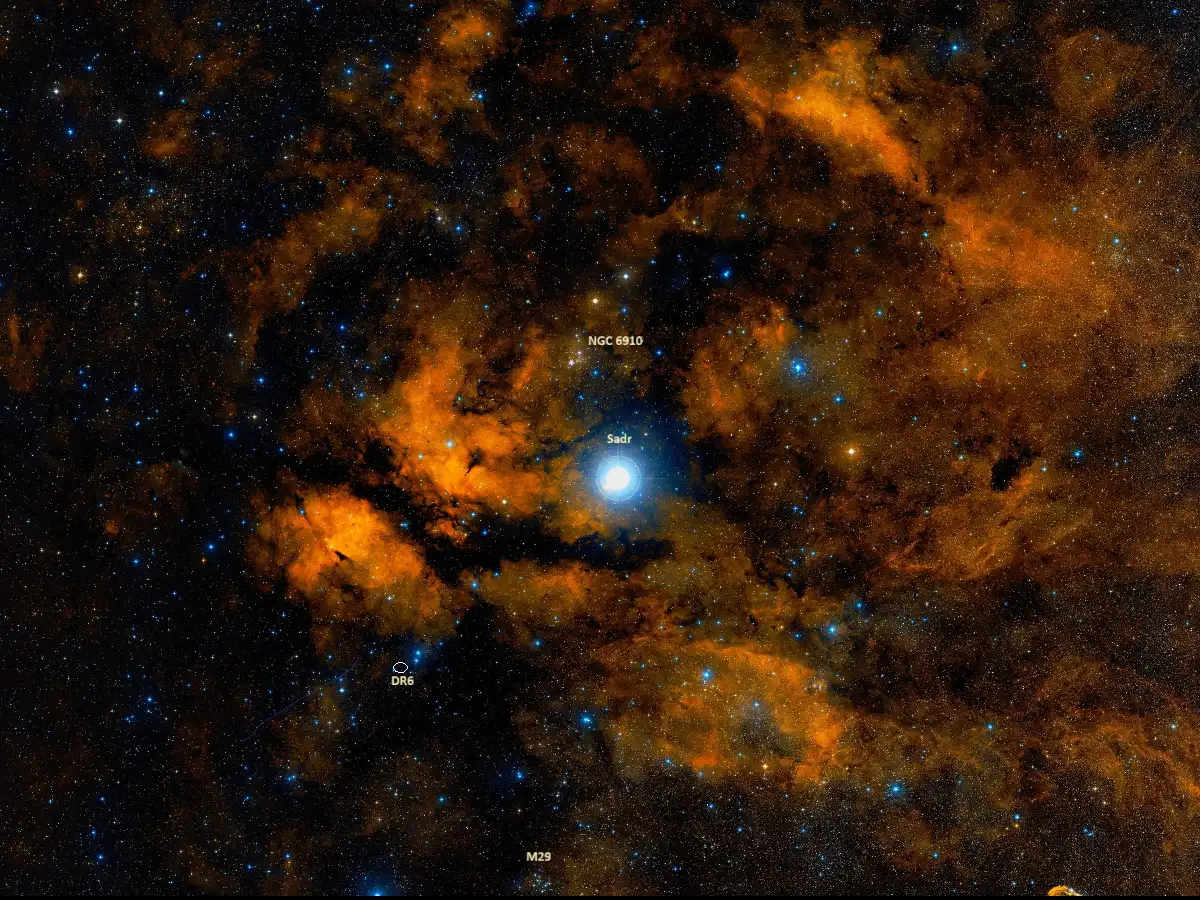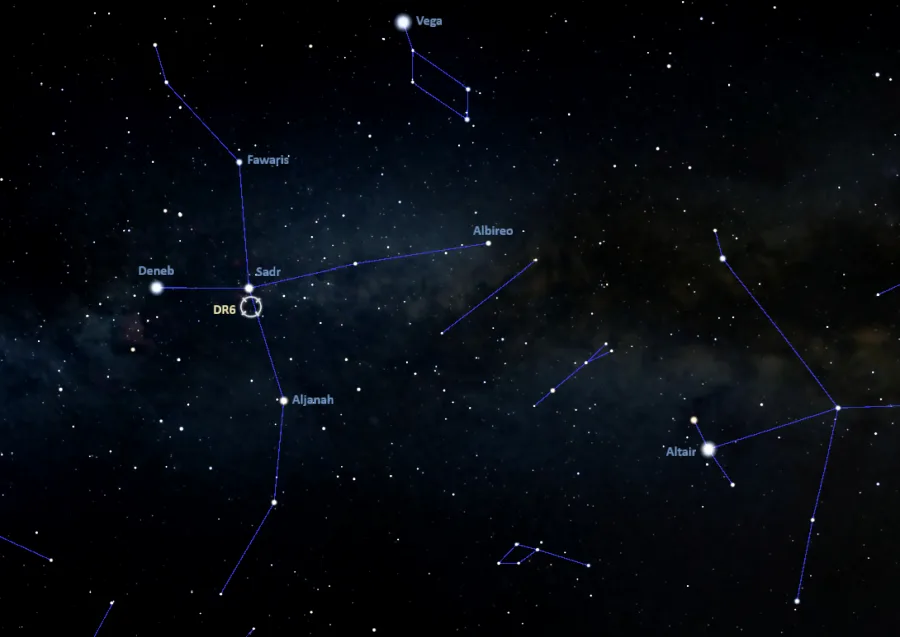DR 6 is a star forming nebula located approximately 3,900 light years away in the northern constellation of Cygnus (the Swan). Nicknamed the Galactic Ghoul, the nebula lies in the plane of the Milky Way and contains a cluster of young, massive, newly formed stars. It was famously captured by the Spitzer Space Telescope in infrared light in 2003.
The star-forming region has an apparent size of 3.7 by 2.9 arcminutes. It appears near the edge of the vast Gamma Cygni Nebula in the sky, close to the supergiant Sadr (Gamma Cygni) at the centre of the Northern Cross. However, it is not associated either with Sadr or with the large H II region that surrounds it. The yellow-white supergiant lies 1,800 light-years away and the Sadr Region is approximately 4,900 light-years away.
The Galactic Ghoul is a large cloud of gas and dust lit by the young stars within. It has an extended halo visible in the far-infrared part of the spectrum. The central portion of the nebula, which contains a young cluster of ten massive stars, is roughly 3.5 light-years across, a little less than the distance from the Sun to the Alpha Centauri system. The young cluster is catalogued as ECX6-15.

A “monster” lurking behind a blanket of cosmic dust is unveiled in this Halloween image from NASA’s Spitzer Space Telescope. Resembling a ghoul with two hollow eyes and a screaming mouth, this masked cloud of newborn stars was uncovered by Spitzer’s heat-seeking infrared eyes. The spooky cloud — a nebula called “DR 6” residing in the plane of our Milky Way galaxy — is home to a cluster of about 10 massive newborn stars, ranging in size from 10 to 20 times the mass of our Sun. The nebular “eyes” and “mouth” were carved out by intense heat and winds, which shoot outward from the stars (located in the central bar or “nose”). The green material remaining in the eyes and mouth is comprised of gas, while the red regions and tendrils beyond make up the dusty cloud that originally gave birth to the young stars. Within the nebula’s nose, a second generation of stars is in the process of forming. These stars, in turn, will sculpt their stellar nursery, and ultimately affect the birth of yet another generation of stars. Spitzer provides astronomers with an unprecedented combination of sensitivity and spatial resolution to study this cycle in detail. This image composite was taken on Nov. 27, 2003, by Spitzer’s infrared array camera. It is composed of images obtained at four wavelengths: 3.6 microns (blue), 4.5 microns (green), 5.8 microns (orange) and 8 microns (red). Image credit: NASA/JPL-Caltech/S.Carey (Caltech) (PD)
The nebula has been nicknamed the Galactic Ghoul because its clouds form a shape similar to that of a human face, with prominent cavities that appear like the eyes and mouth of a cosmic spectre. It shares the nickname with the interacting pair of galaxies catalogued as Arp-Madore 2026-424 (AM 2026-424) in the southern constellation of Microscopium.
The cavities in the Galactic Ghoul have been carved out by the intense stellar winds from the young stars at the nebula’s centre. The young star cluster appears in the region of the Ghoul’s nose.
The catalogue designation DR 6 comes from the initials of the astronomers D. Downes and R. Rinehart, who listed the nebula as the sixth object in their 1966 study based on microwave observations of Cygnus X. Cygnus X is one of the most massive star forming regions in the Milky Way.

DR 6 and the Gamma Cygni region, image credit: ESO/Digitized Sky Survey 2 (CC BY 4.0)
In 1977, Higgs et al. found that the nebula had two components, a core region around 3 arcminutes across and a halo region with an angular size of 9 arcminutes at 10.6 GHz.
In 1986, observations in the far-infrared and radio wavelengths led astronomers to conclude that DR 6 is powered by a cluster of late O- and early B-type stars with ages of only 100,000 years or less. A study led by S. Odenwald of the E. O. Hulburt Center for Space Research, Washington, DC, found that, in the far-infrared, DR 6 was dominated by a large extended halo. Observations with the Very Large Array (VLA) revealed six discrete sources within an area 3 arcminutes in diameter. The sources contribute only 10% of the total radio emission from the nebula.
The Galactic Ghoul cannot be observed in backyard telescopes. It appears near the supergiant Sadr (Gamma Cygni) at the chest of the celestial Swan. Sadr is one of the easiest northern stars to identify. It marks the centre of the Northern Cross, a bright, large asterism also formed by Deneb (Alpha Cygni), Albireo (Beta Cygni), Aljanah (Epsilon Cygni), and Fawaris (Delta Cygni). In the northern hemisphere, the Northern Cross dominates the evening sky throughout the late summer and early autumn months.
DR 6 is one of the many well-known nebulae in the region of the Northern Cross. Others include the North America Nebula (NGC 7000) and the Pelican Nebula (IC 5070) near Deneb, the Gamma Cygni Nebula (IC 1318) and the Crescent Nebula (NGC 6888) near Sadr, the Veil Nebula near Aljanah, and the Tulip Nebula (Sh2-101) near Eta Cygni.

Location of DR 6, image: Stellarium
DR 6
| Constellation | Cygnus |
| Object type | H II region |
| Right ascension | 20h 27m 13.1s |
| Declination | +39° 26′ 08″ |
| Apparent size | 3.7′ × 2.9′ |
| Distance | 3,900 light years (1,196 parsecs) |
| Names and designations | Galactic Ghoul, DR 6, 18P 37, ECX6-15, 19P 4, [LZZ97] 8 |